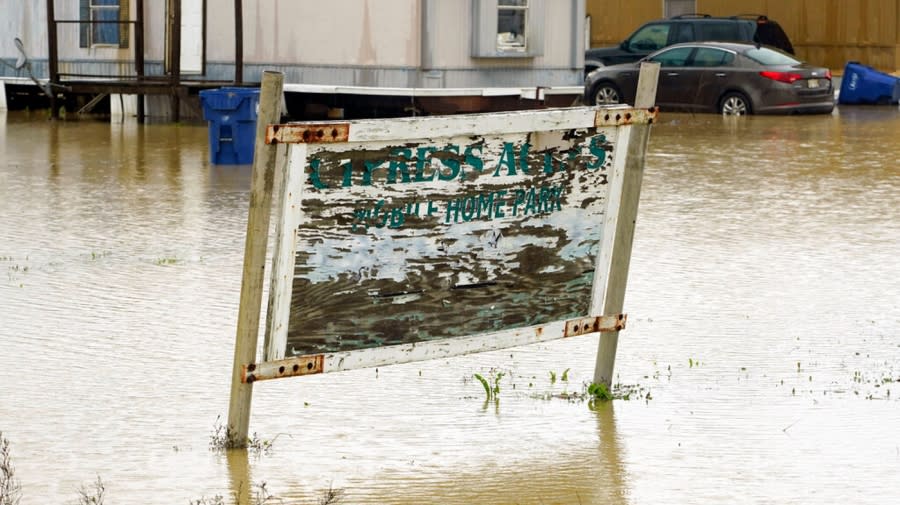NASA satellite to survey worldwide water from space
Equilibrium is a newsletter that tracks the growing global battle over the future of sustainability. Sign up here or in the box below.
Thank you for signing up!
Subscribe to more newsletters here
The latest in politics and policy. Direct to your inbox. Sign up for the Equilibrium newsletter
An international satellite mission is scheduled to blast off from California on Thursday, with the goal of mapping the world’s water resources like never before.
The science initiative, led by NASA, will conduct a comprehensive survey of the planet’s oceans, lakes and rivers for the first time, according to Reuters.
The Surface Water and Ocean Topography advanced radar satellite — dubbed SWOT — aims to give researchers a detailed window into the resource that covers 70 percent of the planet, Reuters reported.
This information intends to shed light on the mechanics and impacts of climate change, according to the outlet.
One specific application of the satellite involves better understanding the role of carbon dioxide in climate change, NASA chief scientist Katherine Calvin said at a press briefing, covered by Space.com.
SWOT will launch aboard a Falcon 9 rocket, owned by Elon Musk’s company SpaceX.
The satellite has been in development for 20 years — designed by NASA’s Jet Propulsion Laboratory, in collaboration with French and Canadian partners, Reuters reported.
Welcome to Equilibrium, I’m Sharon Udasin. Today we’ll start in the South, where a series of tornadoes have left at least two dead. Then we’ll head to Ukraine, where rampant infrastructure attacks are endangering millions of children. Plus: A “keystone” species of the U.S. West gets new protections.
Tornadoes batter South; at least 2 dead

At least two people, including a mother and a son, were killed as multiple tornadoes swept through the South late Tuesday night, our colleague Jared Gans reports.
Destruction and devastation: The mother and her child were killed in the northern Louisiana town of Keithville, where their home was destroyed during the storm.
The boy was found dead in a wooded area more than a half mile from their home, located on the western side of the state.
His mother was discovered dead one street away from their home, according to Caddo Parish Sheriff Steve Prator.
Houses shake, roofs collapse: About 100 miles away in Farmerville, resident Tiyia Stringfellow said she and her family were in their apartment during the tornado, according to CNN.
“We were in the kitchen closet,” she told CNN. “The whole house was shaking.”
While her family members weren’t injured, Stringfellow said she saw her “roof cave in.”
Up to a dozen twisters: About 20 individuals from Farmerville were taken to the hospital after the tornado inflicted considerable damage on the region, Gans reported.
Video footage and eyewitness accounts confirmed at least five tornadoes in northern Texas on Tuesday.
The National Weather Service believes that as many as a dozen may have occurred.
Coast-to-coast impacts: The winter storm system responsible for the tornadoes first moved onshore this weekend in the Pacific states, bringing rain to coastal California and snow to the Intermountain West, as we reported.
The system then moved eastward, bringing blizzard-like conditions to the Northern Plains and tornadoes to the South.
Snow, too: Heavy snowfall and ice shut down highways and caused whiteout conditions in the Northern Plains on Tuesday and Wednesday, according to Fox Weather.
The storm was barreling through the region, as blizzard warnings remained in effect across eastern Wyoming, western South Dakota, western Nebraska and part of southeastern Montana.
Fox Weather described scenes like a jackknifed truck as “common sights” along highways.
It’s not over yet: More severe storms are expected in the central Gulf Coast, which includes New Orleans and southern Louisiana, as well as Mississippi, Alabama and the Florida Panhandle.
More tornadoes could occur in this region.
Meanwhile, up to 2 feet of snow is possible in some parts of western South Dakota and northwestern Nebraska, which could also face more than 50-mile-per-hour winds.
Children at risk amid attacks on Ukraine energy: UN

Russia’s persistent attacks on Ukraine’s critical energy infrastructure have left nearly 7 million children at risk this winter, UNICEF warned on Wednesday.
Bleak winter ahead: Almost every Ukrainian child lacks sustained access to electricity, heating and water — conditions that threaten health and safety as temperatures continue to plunge, according to UNICEF.
“Millions of children are facing a bleak winter huddled in the cold and the dark, with little idea of how or when respite may arrive,” Catherine Russell, executive director of UNICEF, said in a statement.
More than just cold: Winter temperatures in Ukraine can drop to minus 4 degrees Fahrenheit or below, exposing residents to extreme cold, the United Nations agency stated.
Without electricity, children will also be unable to access online learning opportunities.
Remote learning became a primary source of education after so many schools were damaged or destroyed.
Health hazards: Medical facilities may also fail to provide critical services, the agency warned.
Malfunctioning water systems could increase the already high risks of contracting pneumonia, seasonal flu, waterborne diseases and COVID-19.
“Children are also deprived of the ability to learn or stay connected with friends and family, putting both their physical and their mental health at desperate risk,” Russell said.
A system in shambles: Intensified Russian attacks in October ravaged 40 percent of Ukraine’s power production.
By the end of November, the Ukrainian energy system was still only able to cover 70 percent of peak demand, according to the U.N. Office for the Coordination of Humanitarian Affairs.
Psychological toll: While most of Ukraine’s children are at risk, the situation remains especially acute for 1.2 million children and for 6.5 million individuals of all ages, UNICEF stated.
About 1.5 million children are at risk of depression, anxiety, post-traumatic stress disorders and other mental health issues, the agency added.
The rules of war: Russell called for the safekeeping of both children and civilian infrastructure, stressing that humanitarian agencies must have “rapid and unimpeded access to children and families in need.”
“The rules of war are clear — children and the essential civilian infrastructure they rely on to survive must be protected,” Russell added.
To read the full story, please click here.
Western mountain pine gets endangered protections
The U.S. Fish and Wildlife Service (FWS) announced Wednesday it would be listing the whitebark pine as a threatened species under the Endangered Species Act.
Critical to the environment: Whitebark pines are what the Fish and Wildlife Service described as “a keystone species,” which live in windy, cold, high-elevation environments across the western U.S. and Southern Canada.
“Extending ESA protections to whitebark pine is critical to not only the tree itself, but also the numerous plants, animals, and watersheds that it supports,” Matt Hogan, FWS service regional director, said in a statement.
Food source to grizzlies: This five-needled pine species impacts the health and lifecycles of other mountain inhabitants and plays a critical role in curbing runoff from snowmelt, according to FWS.
The trees also provide a high-energy food source to animals.
Whitebark pine nuts are rich in fats, carbohydrates and protein — making them an important snack for grizzly bears before denning, according to the National Parks Service.
Fungus, beetles, fire, climate: Despite its importance, the tree species “is likely to become endangered in the foreseeable future throughout its range,” according to FWS.
The primary threat to the tree is “white pine bluster,” a non-native fungal disease.
Other threats include mountain pine beetles, altered wildfire patterns and climate change.
Scientists estimate that as of 2016, as many as 51 percent of all standing whitebark pine trees were dead.
Keeping trees in place: Providing endangered species protections to the whitebark pine will help support research efforts on conservation, according to FWS.
It will also become illegal to remove, process or damage the trees on federal lands.
The protections will also prohibit interstate or foreign commerce — including the import or export — of the tree.
All the help they can get: “These exceedingly beautiful trees are an icon of our western mountains,” Noah Greenwald, endangered species director at the Center for Biological Diversity, said in a statement.
“They need all the help they can get, including protection from development,” Greenwald added.
The final rule to list the whitebark pine as a threatened species will be published on Thursday in the Federal Register but is available here for public inspection.
Please click here for the full story.
Amazon swapping out generators for batteries

Amazon Studios is beginning to swap out diesel generators with portable batteries on its film and television production sets, the company announced on Wednesday.
Powering a rom-com: The batteries, developed by Moxion Power, are already being used to power cameras, base camps, lighting, hair and makeup trailers on the sets of rom-com “Sitting in Bars with Cake” and the series “Bosch: Legacy,” according to Amazon.
Expansion on the horizon: The e-commerce giant said in a statement that it intends to expand the use of these batteries to more U.S.-based Amazon Studio production sets in 2023.
Among the films slated to benefit from the switch will be “Candy Cane Lane,” a holiday movie featuring Eddie Murphy, the announcement added.
Widespread appeal: “Moxion Power’s batteries are allowing us to deliver entertainment with lower emissions than before,” Glenn Gainor, head of physical production for Amazon Original movies, said in a statement.
Such a transition is important to customers, Hollywood talent and production teams, while benefiting the communities where filming occurs, according to Gainor.
Small changes, big impact: Amazon invested in Moxion Power’s technology earlier this year through its Climate Pledge Fund.
This $2 billion corporate venture capital fund finances clean-tech firms capable of helping Amazon reduce its carbon footprint.
The switch from diesel to batteries helps “demonstrate to others in the entertainment industry that small changes” can bring “an immediate and significant environmental impact,” Gainor said.
Is the electricity supply reliable? The batteries are supported by a swap service, which helps ensure consistent electricity supplies during film operations, the Amazon announcement said.
Performance of the batteries can be monitored remotely.
Artificial intelligence helps predict usage patterns and run times, which can last for days or weeks.
The power of Hollywood: “There is no bigger voice in the world than Hollywood,” Alex Meek, co-founder and president at Moxion Power, said in a statement.
The integration of Moxion’s technology shows “that the entertainment industry is ready and willing to begin the transition to cleaner energy,” Meek added.
To read the full story, please click here.
Wildlife Wednesday
Sustainable shell-fishing to protect marine life, manatees to get help finding food and a Colorado elk gets help from wildlife officers.
Conserving marine life through sustainable shell-fishing
North Carolina fisherwoman Ana Shellem, of Shell’em Seafood, has transformed her solo shop into a sustainable — and successful — boutique shellfish company, featured in a New York Times profile. A conservation advocate and overfishing opponent, Shellem will not harvest one critter beyond the orders she receives, the Times reported.
Florida wildlife officials to resume manatee feeding program soon
A manatee feeding program launched in Florida last year may begin this weekend, as a cold front drives the animals into warmer waters where their primary food source, sea-grass, is not readily available, local NPR affiliate WQCS reported. Officials told WQCS they have romaine and butterleaf lettuce on hand and are ready to resume the program.
Colorado wildlife officers rescue elk stuck in a mud hole
Colorado Parks and Wildlife officers recently rescued a young bull elk that was stuck up to its neck in mud, local NBC affiliate 9News reported. After U.S. Forest Service workers found the animal in distress and unable to get out, wildlife officers had to use a four-wheeler and two racket straps to retrieve the animal, according to 9News.
Please visit The Hill’s Sustainability section for more and check out other newsletters here. We’ll see you tomorrow.
For the latest news, weather, sports, and streaming video, head to The Hill.

